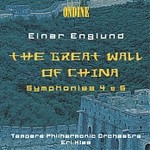
Symphony No. 4 'Nostalgic' / Symphony No. 5 'Fennica' / The Great Wall of China
 $35.00
Out of Stock
$35.00
Out of Stock6+ weeks add to cart
EINAR ENGLUND
Symphony No. 4 'Nostalgic' / Symphony No. 5 'Fennica' / The Great Wall of China
Tampere Philharmonic Orchestra / Eri Klas
[ Ondine / CD ]
Release Date: Wednesday 20 September 2006
This item is currently out of stock. It may take 6 or more weeks to obtain from when you place your order as this is a specialist product.
"Einar Englund's incidental music will delight and astonish music lovers looking for a refreshing new experience... a delicious Rumba, a bluesy Jazz-intermezzo, and best of all, an absolute scream of a March a la Shostakovich... A more immediately appealing, witty, masterfully crafted score hasn't come my way in many a moon."
ClassicsToday.com
"Finnish composer, Englund is yet another resolute tonalist. When the great twelve-tone 'freeze' came from the late 1950s to the early 1970s Englund laid down his pen. By then there had been two symphonies, closer to Dmitri than to Jean. In 1972 his hibernation ended with the premiere of his Third Symphony after which his productivity continued steadily. His style remained pretty consistent both pre and post 1960s: essentially tonal music given spice by dissonance.
The Great Wall of China is a surrealist play by Max Frisch. Englund's incidental music (1949) was for a theatre band of seven. Later arranged for full orchestra the eight movements are closer to Prokofiev than Shostakovich with some swell-chested oompah music thrown in. The intermezzo's 'metropolis solitude' jazz is effective at that level without having any knowledge of any satire intended by the composer (se liner notes). Khachaturian's film music and The Love for Three Oranges are the best parallels I can come up with for other influences. The brass writing sometimes recalls Malcolm Arnold and in the two symphonies the bleaker Arnold is also a transient visitor.
The Fourth Symphony is for forces recalling Bartok's Music for Strings, Percussion and Celesta. The first movement is powerfully driven with the tensest of writing for strings (Shostakovich 6 and 8 and Sibelius 4). The Tempus Fugit movement flies along like the presto passages in Shostakovich's Symphony for Strings punctuated by the sort of explosive percussion familiar from Waxman's Sinfonietta and Shchedrin's Carmen ballet. Only in the Finzi-Bach-like Nostalgia does sentimental respite come. The dancing dark and light ballet music of Prokofiev unflinchingly enlivens the finale.
The single-movement Fennica symphony is said to be Englund's true 'War Symphony' (Symphony No. 1 carries that title). He had served during WW2 for four years at the Front and his harrowing war experiences are focused into this work thirty-five years after the events that gave it birth. Battering side-drums, barrages of percussion, frozen snowy landscapes, wheezy ghostly woodwind, mercilessly exciting fanfares (8.19) all stalk through the symphony. Fennica is dedicated to former President of Finland, J S Paaskivi.
The sound quality throughout is startlingly immediate. Ondine are at the forefront of Finnish music and their releases are reliably well documented, recorded and performed. Their reputation continues securely in the hands of this disc."
- MusicWeb
Tracks:
Symphony No. 4 Nostalgic (1976) [25.18]
Symphony No. 5 Fennica (1977) [18.45]
The Great Wall of China (1949) [20.08]
